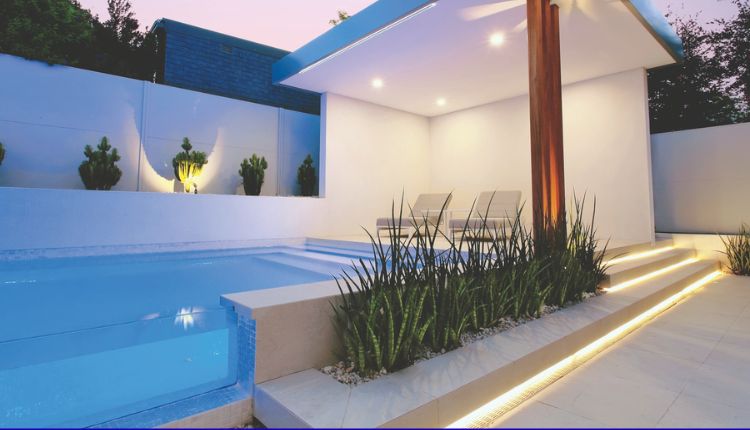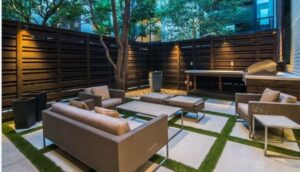
Design
At its core, Modern Minimalist Poolside in Landscape Design is about distilling outdoor luxury to its most refined, essential elements. Rather than layering ornamentation atop extravagance, this approach prioritizes clarity of form, restraint in material palettes, and a purposeful integration of water, architecture, and landscape. The pool becomes less of an add-on and more of a sculptural gesture, an elemental presence that complements its surroundings rather than competes with them.
These guiding ideas allow outdoor spaces to feel serene, deliberate, and timeless. By embracing minimalism around the pool, you allow light, reflection, and the interplay of shadow to become key components of the aesthetic.
If you embrace the philosophy behind Modern Minimalist Poolside in Landscape Design, your outdoor environment becomes a canvas of clarity, calm, and intention. By balancing material honesty, lighting restraint, spatial elegance, sustainable systems, and a subtle dialogue with interiors, you achieve a space that is both luxurious and serene. The anchor principle of Low-Maintenance Landscape Design underscores that beauty and ease need not be mutually exclusive, as the right choices yield a refined, enduring sanctuary with minimal upkeep.
How Minimalism Elevates Poolside Landscapes
Minimalist design doesn’t mean barren or cold. Rather, it elevates the landscape by giving each element meaningful weight. In a richly detailed garden, a striking water feature or elegant line of paving might get lost among clutter. In a minimalist environment, even a single sculptural palm or shadow line becomes potent.
Here’s how minimalism adds value:
- Visual Breathing Room — Negative space frames features rather than dilutes them.
- Focus on Essence — You see the water’s edge, the stone, the plant — nothing superfluous.
- Enhanced Light and Reflection — With fewer distractions, the pool surface mirrors the sky and the shift of clouds more purely.
- Timelessness — Trends fade; the appeal of reduction often endures.
In essence, minimalism elevates landscape design to a form of architectural choreography, where each element plays a clear role and every decision is deliberate.
Balancing Simplicity and Luxury in Outdoor Spaces
One challenge in the minimalist realm is to avoid sterility. The goal is a refined, luxurious atmosphere achieved not by volume, but by the quality of detail, materials, and spatial relationships.
Strategies for balance:
- Layer subtle luxuries — A thin ribbon of water overflow, a flush linear LED strip in the coping, or gently waving grasses introduce sophistication without clutter.
- Highlight tactile materials — A honed stone deck or brushed concrete surface becomes a tactile delight, elevated by its simplicity.
- Juxtapose textures — Contrast smooth surfaces with fine gravel, linear grooves in pavers, or the vertical rhythm of reeds or slender evergreens.
- Use limited accent features — One sculptural planter, a minimalist fire bowl, or recessed bench seats can serve as focal points.
- Mindful proportions — Generous spacing, proportionate margins, and spatial symmetry lend scale and luxury.
Thus, the “luxury” in a minimalist outdoor space is not in lavish scatterings of items, but in the harmony, restraint, and material finesse.
Top Materials for a Modern Minimalist Pool Area
Material selection is pivotal for achieving the right aesthetic and function in Modern Minimalist Poolside in Landscape Design. The materials must age gracefully, resist harsh outdoor conditions, and carry the weight of understated elegance.
Key material categories:
- Natural Stone & Slate
— Large-format slabs, honed or brushed finishes, in subtle neutrals like greys, off-whites, or charcoal.
— Use consistent stone for coping, walkways, and terraces for visual continuity. - Refined Concrete & Micro-Concrete
— Polished or exposed aggregate surfaces, carefully detailed edges.
— Integral for crisp transitions and minimal joints. - Porcelain or Large-format Tile Pavers
— Engineered to resist fading, slip, and temperature fluctuation.
— Their uniformity and precision suit a minimalist vocabulary. - Composite Decking (High-end, low gloss)
— Looks like timber but with less maintenance. Ideal for Design around pool edges. - Fine Gravel, Decomposed Granite, or Washed Pebbles
— As infill areas or transition swaths, these materials soften hardness without overt patterning. - Statement Metals (Corten, Anodized Aluminum, Stainless Accents)
— For coping trims, water features, or minimal fences — accents rather than dominants.
In choosing materials, aim for continuity, tonal restraint, slip-resistance, durability, and minimal joints or grout lines.
Integrating Water, Stone, and Greenery Seamlessly
In the ideal modern minimalist poolscape, water, stone, and planting form a unified composition rather than three disjointed layers. Integration must be seamless, even on transitions.
Principles of seamless integration:
- Flush transitions — Let paving meet water edge cleanly; avoid raised curbs or abrupt demarcations.
- Overflow edges — A narrow perimeter overflow channel blurs boundaries and recirculates surface water, reinforcing water as part of the landscape.
- Hidden drainage — Slit drains or linear drains tucked into joints prevent visible clutter.
- Monochromatic planting massing — Use one or two well-chosen species (ornamental grasses, bamboo, boxwood ribbons) for calm repetition.
- Planter recesses or troughs in stone — Embedding plant pockets within hardscape ensures continuity and avoids “pots on paving.”
- Floating planting beds or plinths — Minimal elevated planters can serve as sculptural punctuation without breaking the formal rhythm.
- Soft edges with gravel infill — Where paving ends, a strip of fine gravel or pebbles eases the visual stop
By composing with restraint and intention, you can let water, stone, and greenery breathe together.
Lighting Ideas for a Serene Minimalist Pool Ambience
Lighting transforms a minimalist poolscape after dusk; it must be as invisible as possible while enhancing key elements. The aim is subtlety, layers, and purposeful emphasis.
Lighting strategies:
- Recessed linear LED in coping joints — A continuous, soft band of light that defines the pool’s edge without fixtures.
- Underwater LED washes — Gentle illumination from within the pool adds a quiet glow.
- Step riser or tread lighting — Embedded, low-glare strips highlight circulation paths.
- Uplights for slender planting — Warm accent light on bamboo, reeds, or vertical shrubs, casting elegant silhouettes.
- Wall-wash lighting — On retaining walls or planar facades, softly illuminating textural surfaces.
- Floating or integrated light planes — Slim floating luminaires or LED strips within stone channels maintain minimal clutter.
- Smart controls & dimming — The ability to adjust intensity or scene mood (e.g. twilight, party, calm) is essential.
- Solar or fiber-optic accent lights — In zones away from power, discreet solar fixtures can serve ambient roles.
A well-layered lighting scheme ensures safety, accentuates textures, and retains the serene minimalism of the space.
Furniture and Decor Essentials for Minimalist Poolscapes
In contrast to traditional outdoor spaces that favor abundance, a minimalist poolscape calls for a curated, functional, and visually light set of furniture and decor.
Essentials to consider:
- Slim-profile lounge chairs — Aluminum or powder-coated steel frames with weather-proof sling or mesh surfaces.
- Low-slung daybeds or modular seating — Simple geometric forms, often with hidden legs, to minimize visual weight.
- Minmalist side tables — Clean block or slab shapes in materials such as concrete, aluminum, or simple stone.
- Shade elements — A flat cantilever umbrella or linear pergola with a taut shade cloth that echoes the geometry.
- One sculptural element — Perhaps a slender fire bowl, water sculpture, or discrete planter as a visual anchor.
- Neutral textiles — Cushions and fabrics in muted tones (off-white, greys, earthy tones), with fast-drying, UV-resistant materials.
- Integrated storage — Built-in benches or concealed storage boxes to avoid clutter.
Each piece must earn its place: comfort, durability, and authenticity over decoration.
Sustainable Choices in Modern Poolside Design
A modern minimalist poolscape need not ignore environmental responsibility. In fact, sustainability can complement minimalism by reducing waste, energy use, and maintenance burdens.
Key sustainable strategies:
- Native, drought-tolerant planting — Reduces irrigation and supports biodiversity.
- Smart irrigation (drip, zoned, moisture sensors) — Deliver water precisely and avoid overwatering.
- Permeable paving or jointed stone — Allows stormwater infiltration instead of runoff.
- Solar-powered lighting and pumps — Offset energy consumption with renewable sources.
- High-efficiency pool filtration & heating systems — Minimize chemical and energy needs.
- Recycled/reclaimed materials — Use reclaimed stone, composite decking from recycled plastics, or sustainably sourced wood.
- Greywater reuse or rainwater capture — For landscape irrigation or auxiliary systems.
- Low chemical regimes — Use salt systems or UV sterilization where possible to reduce harsh chemicals.
These choices mesh naturally with minimalism: fewer inputs, lower impact, and a more sustainable outcome. In fact, by marrying minimal palettes and thoughtful systems, your design can exemplify what sustainable landscaping advocates as functional, beautiful, and resource-aware.
Creating Flow Between Indoor and Outdoor Spaces
One of the most refined aspects of modern minimalist poolside design lies in achieving seamless continuity between interior and exterior realms. This indoor-outdoor dialogue is essential in making the poolside feel like an extension of the home rather than a disconnected appendage.
Approaches to create flow:
- Material continuity — Using the same flooring or stone inside and out (or carefully matched tones) blurs the threshold.
- Flush thresholds & sliding glazing — Pocketing sliding doors or full-height glass that disappears entirely.
- Aligned axes & sightlines — Align corridors, terraces, and pool edges with internal architectural axes.
- Transparent enclosures or minimal framing — Reduces the visual barrier between inside and out.
- Shared color and texture palettes — A restrained palette carries from the interior to the landscape.
- Transition zones (loggias, overhangs) — Covered outdoor rooms with shadow, yet openness, mediate the shift.
- Cross-ventilation and spatial extension — Orient doors and windows to harness breezes and ambient outdoor air flow.
When done well, the boundaries dissolve and the poolside feels like a natural part of the home’s living fabric.
Inspirational Modern Minimalist Pool Designs Around the World
Around the globe, many exemplary projects embody the spirit of Modern Minimalist Poolside in Landscape Design. A few instructive glimpses:
- In desert climates, architects employ linear reflecting pools beside cantilevered modern homes, framing dramatic sky vistas with minimal planting.
- In Mediterranean settings, olive trees and clipped hedges flank geometric infinity-edge pools, creating a serene composition of light, form, and space.
- Japanese-inspired minimalism often pairs black slate surrounds, glassy water mirrors, and singular sculptural planting, quiet, meditative, and precise.
- Scandinavian projects sometimes incorporate moss gardens, simple birch groves, and light-hued stone terraces that echo Nordic restraint.
- In tropical contexts, designers sometimes embed pools within a neutral stone shell, with vertical palm trunks or bamboo groves rising like colonnades.
Each of these projects illustrates how constraint, clarity, and a disciplined hand can create an expressive, timeless outdoor statement. They validate that Modern Minimalist Poolside need not sacrifice richness; it simply requires a more thoughtful choreography.







